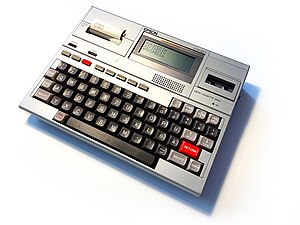Epson HX-20
| Epson HX-20 | |
|---|---|

|
|
| Manufacturer | Epson |
| Sales start | 1982 |
| Technical specifications | |
| processor | 2 × Hitachi 6309 |
| random access memory | 16 KiB |
| screen | LCD 120 × 32 pixels |
| Connectivity | |
|
connections |
|
The Epson HX-20 (also known as the HC-20) was the first real laptop computer. The basic design from July 1980 comes from Yukio Yokozawa. Yokozawa worked for the Japanese company Suwa Seikosha, a subsidiary of Seiko (now Seiko Epson ). He received a patent for his invention. The device was introduced in 1981 in Japan as the HC-20 and in North America and Europe as the HX-20. The delivery took place in the summer of 1982.
Hardware equipment
In the basic configuration, the Epson HX-20 is about as wide and long as a DIN A4 page and 4 cm thick with a weight of 1.6 kg.
The device has a full-size keyboard, rechargeable nickel-cadmium batteries , a built-in LCD screen with a resolution of 120 × 32 pixels for four lines of 20 characters each. As an additional output device, the Epson HX-20 has a matrix printer , as was also the case with commercial pocket calculators. A built-in micro cassette recorder serves as the standard storage medium .
Two Hitachi 6301s (improved version of the Motorola 6801 ) with 614 kHz each are used as the central processing unit . The standard memory is 16 KiB RAM, expandable to 32 KiB RAM.
Two RS-232 connections are available as communication interfaces for an external printer, a modem or an acoustic coupler ; A serial bus is available for an external monitor or a storage medium such as a floppy disk drive.
Thanks to the efficient system architecture, the Epson HX-20 had a running time of 50 hours with a new battery if the user only uses BASIC or the monitor. Intensive use of the printer and the micro-cassette recorder reduced the overall running time.
Software equipment
The Epson HX-20 uses a proprietary operating system , consisting of the Epson BASIC - interpreter and a monitor program.
legacy
The HX-20 was the first widely available portable computer. Its direct successors are the Epson PX-4, on which the CP / M operating system ran, and subsequently the Epson PX-8 . In 1985 , Tandy Radioshack released the popular TRS-80 Model 100 in a similar design .
Individual evidence
- ↑ Shinshu Seiki / Suwa Seikosha HC-20. In: http://museum.ipsj.or.jp . Information Processing Society of Japan, accessed March 29, 2020 .
- ↑ HX-20. In: Epson. Epson, 1987, accessed March 29, 2020 .
- ↑ a b c d Kenneth Skier: HX-20 Operations Manual. In: Epson. Skisoft, Inc, 1982, accessed March 29, 2020 .


